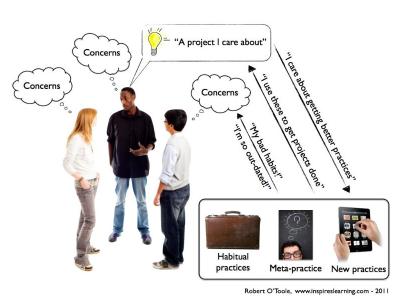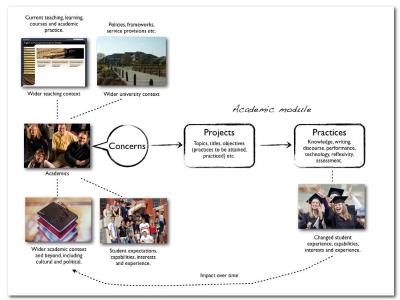OSL for designing a learning ecology
If you want to optimise an existing practice, it is best done in situ. Take a more scientific approach. Set up performance measures, points of objective enquiry, identify the parameters to manipulate, replace old tools with faster more efficient tools. But do it in situ. Optimisation is very much sensitive to implementation details. A practice is usually as it is because it fits with a wider context, a wider ecology. For example, quite often we transfer our use of one technology to a different situation, because that is the quickest route to getting the job done. We might try to optimise tutor-student communications through a VLE, but that will never work in a world where a high proportion of students rarely spend time at a desktop-bound web browser.
In other cases, we need to do something quite different. We need to step back and rethink our habitual practices, to try different patterns and technologies. We don't speed up the practice, we look for something more appropriate. Only then may we make our new pattern more manageable and optimal. We can use Open-space Learning approaches to do this.
OSL helps us to collectively stage the habitual, in an abstract and manageable way. The link to the actual is retained, through a critical awareness of the abstraction. We know it is to some degree virtual, but connected to the actual. The active and conscious elision of detail itself makes us think about what is important. OSL allow us a greater degree of freedom to play with the holistic web of things in the learning ecology. In his book on Educating the Reflective Practitioner, Donald Schön recognised the importance of being able to grasp this interconnectedness:
“Designing is a holistic skill. In an important sense, one must grasp it as a whole in order to grasp it at all. Therefore, one cannot learn it in a molecular way, by learning first to carry out smaller units of activity and then to string those units together in a whole design process; for the pieces tend to interact with one another and to derive their meanings and characters from the whole process in which they are embedded.” 1
Consider how this diagram abstracts key elements of the practice of re-designing a learning ecology:
Click the image to view full size.
Now imagine the three students in an OSL session embodying the dynamics from various conflicting perspectives, playing with different "meta-practices" for change. That should give them an insight into effectively choosing and adopting a new technology within their wider collective context, leading to a more succesful implementation of new practice. At several points in the systematic and creative methodology described above, we need to do precisely this: "use OSL methods to explore the relationships and roles that could make change possible, and the impact of change over time"; "use an OSL approach to create and test narratives about how they might be used". That's the creative element.
Let's apply this to the design or redesign of an academic module. This diagram abstracts some of the key dynamics in the learning ecology:
Click the image to enlarge to full size.
Traditionally, this works by a single academic translating their own academic, aesthetic, political, cultural concerns (which perhaps they feel are representative of the collective concerns of their colleagues) and a niche within the wider degree programme, into the compulsory, optional and possible "projects". This is the stuff from which the module is constituted - for example, the themes, the lectures, the assignments. The available, legitimate, possible practices (including technologies and knowledge practices) give constraints and affordances. Wider institutional constraints further shape the module. Student expectations, capabilities, interests and experiences add a further enabling or constraining dimension. Finally, the module might actively seek to change practices and attitudes, to make new projects possible. This is often the point at which new technologies are added to the mix. For example, the academic might wish to get the students creating entries in a wiki, as a kind of research based learning.
Will it work? Are the assumptions realistic? - especially those about students? Are there any unforeseen consequences?
Why not get a group of students, administrators, technologists, academics into an OSL space and embody the dynamics, experimenting with practices and possible designs? That's what we did when beginning to think about possible designs for new online distance learning courses. It worked well. You can read about it, see photos and a video walkthrough by the students as part of the Designing a Learning Ecology case study.
The case study illustrates one possible method, and some of the factors that make the approach effective. You will see that it took place in the CAPITAL Rehearsal Room at the University of Warwick. In our experience, using just the right spaces is essential for this kind of embodied prototyping.
David Kelley of the IDEO design company has coined the useful phrases “build to learn” and “build to think”2. In an influential Harvard Business Review article 3, Tim Brown describes how design teams at IDEO (consisting of an eclectic range of people including anthropologists, consumers and engineers) work in three distinct “spaces”: inspiration space, ideation space, implementation space. The three spaces are differentiated through having different purposes, different rules, different physical and technical arrangements. But most importantly, they are differentiated by requiring a different attitude from the participants. These attitudes vary along several vectors, including: riskiness/safety, familiar/unfamiliar, considered/impulsive, playfulness/seriousness, divergent/convergent. Different attitudes are appropriate at different times and in different spaces. Spaces can be set aside and configured for activities that embody different attitudes. Technologies can be designed to work with these variations. We might use a different actual space for each, or we can in some way reconfigure a single space for different purposes. The important thing is to know when we are using a space for one of the three – for this to be clear to all participants. To read about an experiment to evaluate the different kinds of spaces available at Warwick, see the 3 Spaces Experiment case study.
And finally...
These methodological considerations have been applied by the OSL project team as they have been developed. A series of case studies, along with a technology wiki have been created from this. The method has now been adopted more widely by IT Services at Warwick for learning technology development. Further case studies will be added. The wiki will be continually updated. If you would like to add your own case study, or become a wiki editor, please contact Robert O'Toole (see the contact link below).
Good luck with your OSL technologizing!
Robert and the OSL team.
1 Donald Schön, Educating the Reflective Practitioner, Wiley, 1987, 158.
2 David Kelley "Prototyping is the Shorthand of Design" in Design Management Journal, Vol 12, No. 3, Summer 2001.
3 Tim Brown, “Design Thinking” in Harvard Business Review, June 2008.
Contents
- Introduction
- Who are you?
- How OSL and technology are intertwined
- What is a learning ecology?
- A systematic and creative method
- OSL for designing a learning ecology
- Case Studies
- A wiki of technologies


